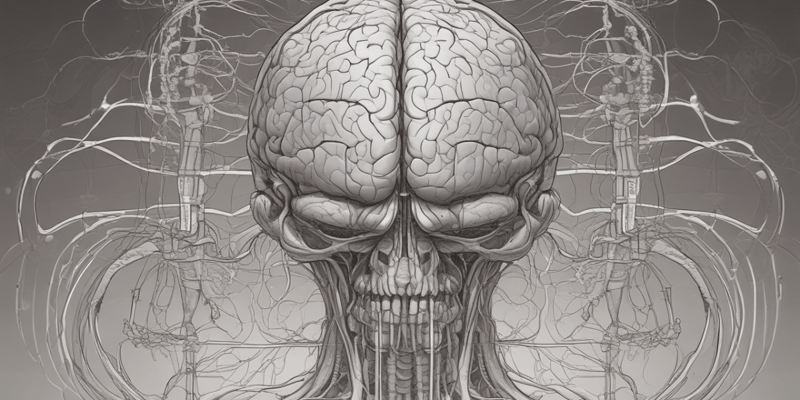Podcast Beta
Questions and Answers
What is the primary function of the basal ganglia in the motor loop?
What is the role of the direct pathway in the basal ganglia?
Which neurotransmitter is responsible for the inhibitory signals in the basal ganglia?
What is the role of dopamine in the basal ganglia?
Signup and view all the answers
Which structure is responsible for sending the excitatory signal to the cortex?
Signup and view all the answers
What is the result of damage to the basal ganglia?
Signup and view all the answers
What is the role of the indirect pathway in the basal ganglia?
Signup and view all the answers
What is the location of the structure that produces dopamine in the basal ganglia?
Signup and view all the answers
Study Notes
Basal Ganglia Function
- The basal ganglia forms a motor loop with the cortex and thalamus, modulating movement via dopamine through internal pathways.
- The basal ganglia has two key roles: shifting between mental sets (body position, movement, complicated behavior, or thought process) and Reinforcement learning is a fundamental concept in both psychology and artificial intelligence, involving the process of learning to make decisions through trial and error, where actions are reinforced based on their outcomes. In the context of the basal ganglia, reinforcement learning plays a crucial role in evaluating the consequences of actions, enabling individuals to adapt their behavior based on positive or negative feedback. This learning mechanism is essential for acquiring new skills, forming habits, and optimizing performance in various tasks. The basal ganglia contribute to this process by integrating sensory information and emotional responses, thereby guiding the development of appropriate behavioral strategies.
Sub-Circuits of Basal Ganglia
- Three important sub-circuits: direct pathway, indirect pathway, and dopamine pathway.
- These sub-circuits are controlled by inhibitory (GABA) and excitatory (glutamate) neurotransmitters.
Direct Pathway
- The direct pathway is characterized by a positive feedback loop that enhances and facilitates cortical function. This process is essential for the coordination of voluntary movements and cognitive functions, as it actively promotes excitability within the cortex.
- The specific pathway involves a sequence of events: starting from the cortex, an excitatory signal is generated, which then travels to the striatum. Here, the excitatory signal prompts the release of inhibitory signals directed towards the globus pallidus internus and the substantia nigra reticular area. As a result, these structures reduce their inhibitory output to the The ventrolateral nucleus (VLo) is a crucial component of the thalamus, serving as a relay station for motor control information. It plays a significant role in regulating voluntary muscle movements by integrating signals from various brain regions, including the basal ganglia and the cortex. The VLo receives inputs that are excitatory in nature, which facilitate the coordination of movement patterns. This nucleus not only contributes to motor processing but also has implications in cognitive functions, making it an essential area of focus in understanding both motor disorders and cognitive impairments.of the thalamus. With the decrease in inhibition, the VLo can more effectively relay excitatory signals back to the cortex without impediment.
- Importantly, even a minor increase in the functional capacity of the cortex has the potential to be self-sustaining and escalate if it is not inhibited by the opposing indirect pathway, which traditionally serves to regulate and balance these excitatory influences.
Indirect Pathway
- Competes with the direct pathway and overall has a suppressive effect on the cortex.
- The pathway: cortex → excitatory signal → striatum → inhibitory signal → globus pallidus externus → increased inhibitory effect on VLo → decreased excitatory effect from VLo to cortex.
- Strengthens the inhibitory effect on VLo, decreasing the excitatory effect from VLo to cortex, resulting in a net suppressive effect.
Role of Dopamine
- Dopamine controls whether the direct or indirect pathway is taken.
- If dopamine is present, the direct pathway is selected; if not, the indirect pathway is selected.
- Dopamine comes from the pars reticulanum/substantia nigra compacta/SNc.
Effects of Basal Ganglia Damage
- Damage to the basal ganglia results in over or under initiation of movements.
- Hypokinetic disorders, such as Parkinson's disease, are characterized by a decrease in voluntary movement and are primarily caused by the overactivity of the indirect pathway within the basal ganglia circuitry. This overactivity is a direct consequence of reduced dopamine levels, which impedes the direct pathway's function. Consequently, patients experience symptoms such as akinesia, which is the inability to initiate movements, and bradykinesia, which is marked by slowed ability to perform movements.
- Hyperkinetic disorders, such as Huntington's disease, are characterized by a predominant underactivity of the indirect pathway in the basal ganglia. This dysfunction causes an imbalance in motor control, resulting in symptoms like dyskinesia—uncontrolled movements—and hypotonia, which manifests as reduced muscle tone and strength.
Studying That Suits You
Use AI to generate personalized quizzes and flashcards to suit your learning preferences.
Description
Learn about the basal ganglia's role in motor control, modulating movement with dopamine, and its two roles in shifting mental sets and reinforcement.




